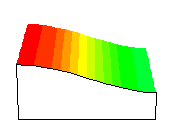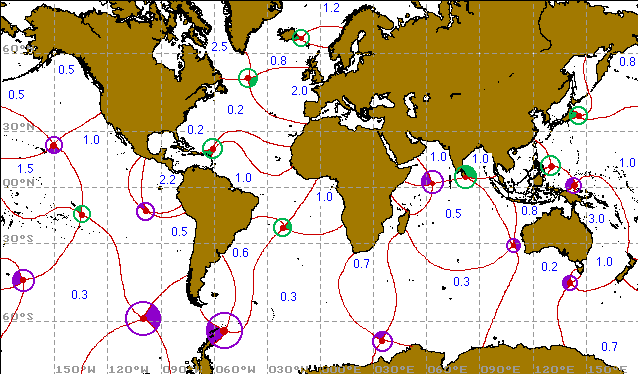Exercise 5: Tides.
Page 23

Let us now return to tides on a rotating earth and look at the situation in large basins.
The rotation of the earth deflects water movement sideways, to the right in the northern hemisphere and to
the left in the southern hemisphere. The tidal wave is therefore pushed towards the right (left) coastline in
the northern (southern) hemisphere. The animation shows how it travels along the coast in the northern
hemisphere, in counterclockwise movement. In the southern hemisphere the movement would be
clockwise.
As a result of movement along the coast the node has shrunk into a single point in the centre of the basin,
known as the amphidromic point. Vertical water movement at the amphidromic point is zero. The tidal
current at the amphidromic point produces water movement on a horizontal circular or elliptic path. Tides in the open ocean take the form of several such systems, where the tidal wave travels around
amphidromic points. Because each tidal constituent has its own period it has its own system of amphidromic points. The observed tide is the sum of the movement produced by all constituents.
Before the 1990s measuring tides in the open ocean was nearly impossible, because there is just no fixed benchmark against
which to measure water level changes of less than 1 m. Today we have a reasonable knowledge of the tides in the deep ocean from satellite altimeter observations, which give the elevation of the sea level accurately to about 5 cm. These measurements confirm earlier ideas about the tides derived from numerical models. As an example, the chart below of the M2 constitutent shows 8 amphidromic points in the Pacific Ocean, 5 amphidromic points in the Indian Ocean and 4
amphidromic points in the Atlantic Ocean. Most amphidromic points in the northern hemisphere show
anticlockwise rotation, while in the southern hemisphere most show clockwise rotation.
 |
| An example of a result from a computer model
of the tides in the world ocean, showing amphidromic points (red circles)
and sense of rotation (purple = clockwise, green = anti-clockwise).
Red lines are co-phase lines indicating the crest of the tidal wave at
0, 3, 6 and 9 lunar hours after the moon's transit through the meridian of
Greenwich; the filled sector of the purple and green circles indicates
the sector between 0 and 3 lunar hours.
Blue numbers indicate the tidal range (m) due to the
M2 tide. In the open ocean
the tidal range is generally small (0.2 - 0.5 m and zero at amphidromic
points). The model indicates large
tidal ranges closer to the coast; but the coarse model resolution does not
reproduce the known extreme tides in the Bay of Fundy or on the French coast.
(These regions show up with very large tidal ranges, though.) |
It is now easy to understand why some places experience larger tides than others. The
tidal amplitude increases with distance from the amphidromic points, so places close to amphidromic points such
as Perth on the Australian wets coast experience small tides. Places far away from aphidromic points like Cape Town on the southern tip of Africa experience large tides. The system of amphidromic points also explains why some ports experience semidiurnal tides, others diurnal tides, yet other mixed tides: Each tidal constituent has its own system of amphidromic points.
A port located close to an amphidromic point of the semidiurnal constituents will not experience much of a
semidiurnal tide; but it may be far away from the amphidromic points of the diurnal constituents and therefore
experience large diurnal tides. Do San, our earlier example for diurnal tides, is in such a location.
Fully diurnal tides are very much the exception. Most ports around the world experience mixed, mainly
semidiurnal tides (form factors in the range 0.25 - 1.5). Regions dominated by diurnal tides are, for
example, parts of the Gulf of Mexico and some coastlines in South East Asia.
 © 2000 M. Tomczak
© 2000 M. Tomczak
contact address:
home page: http://www.es.flinders.edu.au/~mattom
web address of Exercises in Oceanography: http://www.es.flinders.edu.au/~mattom/IntExerc
This page last updated 5 December 1999

